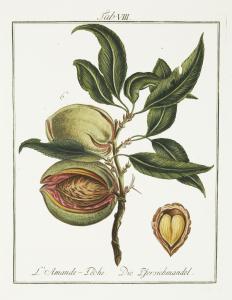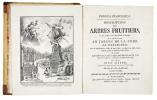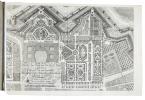Pomona Franconica oder natürliche Abbildung und Beschreibung der besten und vorzüglichen Europäischen Gattungen der Obstbäume und Früchte welche in dem Hochfürstlichen Hofgarten zu Würzburg gezogen werden. Nebst den haupsächlichsten Anmerkungen über deren Erziehung, Propfung und Pflege... Pomona Franconica. Description des Arbres fruitiers, les plus connus et les plus estimés en Europe...
Eur 18,000 / USD 19,800
The price shown on each item does not include V.A.T (Value Added Tax). As a result of the recent EU legislation we are required to charge our EU customers the percentage of V.A.T. charged by the customer’s country of residence, unless they possess a V.A.T. registration number. Postage Additional.
Nürnberg, bey Adam Wolfgang Winterschmidt, 1776-1776. 2 volumes. 4to (245 x 200mm). pp. civ, 152; (4), 364, with engraved frontispiece, 1 folded engraved garden plan, 10 engravings in the text and 110 engraved plates of which 99 spendidly hand-coloured. Contemporary half calf, spines in 6 compartments with gilt ornaments and gilt lettered red and green labels (tiny old repair to top of one volume and foot of the other one).
the most attractive work on fruit published in Germany
A very fine copy, of the most attractive work on fruit published in Germany. "Der Hochfürstliche Hof- und Residenzgärtner Johann Mayer verfasste das bedeutende Werk 'Pomona Franconica...' Im esten Band sind 12 Aprikosen-, 6 Mandel- und 33 Pflaumensorten enthalten, im zweiten 25 Kirschen- und 32 Pfirsichsorten... " (Martini p.70). "A delightful and charming work" (Dunthorne). "Johann Mayer was born in Prague and learned about gardening in France and England before he settled in Würzburg to look after the garden of the Prince-Bishop, Adam Frédéric, Prince of the Holy Roman Empire, Biship of Bamberg and Würzburg, Duke of Franconia, to whom he dedicated his book, which has a bilingual text... the book was intended to raise the standard of fruit-growing in Germany, and Mayer's training in France helped him to do so" (S. Raphael, An Oak Spring Pomona pp. 135-6). A third volume appeared in 1801, in a very small edition and only a few copies survived. The 3 major botanical collections, de Belder, the Oak Spring library and Plesh collection, do not or did not have a copy of this volume. Adam Wolfgang Winterschmidt (1733-1796), the publisher was also the artist and engraver of the plates. The plates are highly finished, many heightened with gum arabic. The 11 plain engraved plates show pruning and grafting techniques and were never coloured. The text both in German and French.
Dunthorne 220; Nissen BBI, 1318; Stafleu & Cowan 5748.


























